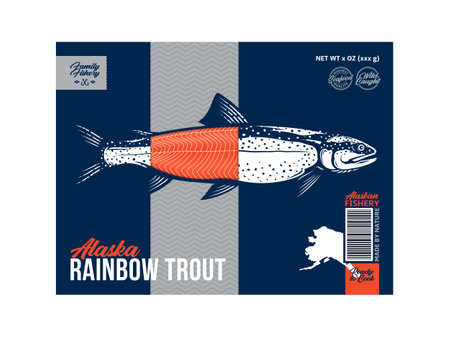Introduction to Rocky Mountain Trout Streams
When you think of trout fishing in America, the Rocky Mountains probably come to mind. Stretching from New Mexico all the way up through Montana and into Canada, these mountains are home to some of the most breathtaking landscapes and crystal-clear streams you’ll find anywhere. For anglers, the Rockies offer a unique blend of adventure, beauty, and a diversity of trout species that make every trip memorable.
The Rockies aren’t just about wide-open vistas and snow-capped peaks; they’re famous for their network of mountain streams. These waters carve their way through thick forests, rocky canyons, and wildflower meadows. The cold, oxygen-rich water is perfect for trout, providing healthy habitats where these fish can thrive. Whether you’re wading into a quiet creek or casting along a rushing river, each stream has its own character—and its own resident trout.
Why the Rockies Are a Trout Fishing Paradise
What sets this region apart is more than just its scenery. The combination of elevation, climate, and geology creates countless spring-fed streams, deep pools, and riffles—ideal conditions for trout. Plus, conservation efforts over the years mean many of these waters remain pristine and well-stocked with native and introduced trout species.
Diverse Trout Species in Rocky Mountain Streams
One reason anglers flock here from all over the country is the chance to target different kinds of trout in one trip. Here’s a quick look at some of the main species you’ll encounter:
| Trout Species | Distinctive Features | Typical Habitats |
|---|---|---|
| Rainbow Trout | Colorful pink stripe along sides; lively fighters | Fast-moving rivers & clear streams |
| Brown Trout | Golden-brown body with black & red spots | Cooler, deeper pools & undercut banks |
| Cutthroat Trout | Red-orange slash under jaw; native to the Rockies | High-elevation creeks & alpine lakes |
| Brook Trout | Marbled pattern on back; white edges on fins | Small mountain brooks & shaded streams |
| Laketrout (Mackinaw) | Large size; pale spots on dark body | Deep mountain lakes (occasionally found near inlets) |
A Place for Every Angler
No matter your experience level or favorite fishing style—fly fishing with dry flies, nymphing in pocket water, or even using ultralight spinning gear—the Rockies have something for everyone. Each stream offers new challenges: reading the current, spotting rising fish, and choosing the right approach for each species. This variety is what keeps both locals and visiting anglers coming back season after season.
2. Knowing Your Trout: Key Rocky Mountain Species
When you’re wading into the cool, clear waters of a Rocky Mountain stream, knowing which trout you’re after makes all the difference. Let’s get to know the main trout species you’ll encounter: Rainbow, Brown, Brook, and Cutthroat. Each has its own unique look, preferred hangouts, and habits. Understanding these traits will help you match your approach to the fish and boost your chances for an unforgettable day on the water.
Rainbow Trout
Identifying Features: Rainbows are easy to spot with their pinkish-red stripe running from gills to tail, peppered black spots across their silvery bodies, and a slightly forked tail.
Natural Habitat: They love fast-moving, oxygen-rich water and often hold in riffles or just below them. In mountain creeks, look for rainbows near submerged rocks and undercut banks.
Behavioral Patterns: Rainbows are active feeders during daylight, especially in the morning and evening. They’ll chase flashy lures or nymphs drifting in the current.
Brown Trout
Identifying Features: Browns have golden-brown bodies covered with black and sometimes red-orange spots surrounded by light halos. Their tails are more squared off than rainbows.
Natural Habitat: Browns favor deeper pools with slower currents, often hiding near fallen logs or overhanging branches where they can ambush prey.
Behavioral Patterns: These trout are shy and often feed at dawn or dusk. They’re known for striking bait aggressively but spook easily in clear water.
Brook Trout
Identifying Features: Small but stunning, brookies have green backs with worm-like markings, white-edged fins, and red spots surrounded by blue halos along their sides.
Natural Habitat: Brook trout prefer cold, spring-fed streams with plenty of shade. You’ll find them tucked away in small pools or under root wads in tight mountain creeks.
Behavioral Patterns: Brookies aren’t picky eaters but tend to strike smaller flies or bait. They’re most active during cool weather and lower light conditions.
Cutthroat Trout
Identifying Features: Named for their bright red or orange slash marks beneath their jaws, cutthroats sport greenish backs with sparse black spots concentrated toward the tail.
Natural Habitat: You’ll find cutthroats in high-elevation streams that stay cold year-round. Look for them in slower runs and deep pockets behind boulders.
Behavioral Patterns: Cutthroat trout are less aggressive than browns but will rise readily to dry flies, especially during summer hatches. They’re most active from late spring through early fall.
Main Rocky Mountain Trout Species at a Glance
| Species | Main Colors & Markings | Favorite Stream Spots | Main Feeding Times |
|---|---|---|---|
| Rainbow | Pinkish stripe, black spots | Riffles, undercut banks | Dawn & dusk |
| Brown | Golden-brown body, black/red spots | Pools near cover (logs/branches) | Dawn & dusk (low light) |
| Brook | Green back, white-edged fins, red/blue spots | Tight pools, shady areas | Mornings & cool weather |
| Cutthroat | Red/orange jaw slash, greenish back | Boulder pockets, slow runs | Latespring–early fall (daytime) |
A Local Tip for Spotting Trout in Rocky Streams
If you’re not sure what’s swimming below the surface, take a few minutes to watch quietly from above. Trout often reveal themselves by subtle movements or flashes as they turn to feed—sometimes all you need is patience and a good pair of polarized sunglasses to spot your target species among the rocks and riffles!

3. Tackle and Techniques for Local Waters
If you’ve ever watched an angler on a Rocky Mountain stream, you’ll notice there’s more to trout fishing here than just tossing out a line. Rocky Mountain streams are dynamic—fast currents, crystal-clear water, and trout that have seen their fair share of baits. To really make the most of your time on these waters, it helps to know what gear works best and how to match your approach to the conditions and species you’re after.
Essential Gear: What Anglers Prefer in the Rockies
Lightweight rods are king in mountain streams. Most local anglers favor 8’6” to 9’ fly rods in 4- or 5-weight for their versatility. Spinning gear can work well too, especially if you’re targeting deeper pools or younger anglers are tagging along. Here’s a quick look at what’s popular:
| Gear Type | Why It Works | When to Use |
|---|---|---|
| 4-5 Weight Fly Rod | Delicate presentation, good for tight spots | Pocket water, riffles, spooky trout |
| Ultralight Spinning Rod (5-7 ft) | Easy casting with small spinners or spoons | Bigger pools, windy days, beginners |
| Floating Line (Fly Fishing) | Best for dry flies and nymphs in shallow water | Clear streams, top-feeding trout |
| Sinking Tip Line (Fly Fishing) | Gets streamers down fast in deeper runs | High water, chasing big browns or rainbows |
Bait, Lures, and Flies: What Works Best?
The choice between bait, lures, or flies often comes down to local regulations and personal preference. In many stretches of the Rockies, artificial-only rules apply—so check before you go! Here’s what locals reach for:
| Species Targeted | Bait/Lure/Fly Choice | Why It’s Effective |
|---|---|---|
| Rainbow Trout | Pheasant Tail Nymphs, Spoons, Salmon Eggs (where legal) |
Mimics natural food sources; flashy lures trigger strikes in clear water |
| Brown Trout | Woolly Buggers, Muddler Minnows, Small Crankbaits |
Browns love bigger prey; aggressive takes especially at dawn/dusk |
| Cutthroat Trout | Parachute Adams Dry Flies, Copper John Nymphs, Panther Martin Spinners (gold blade) |
Loves topwater action and bright, flashy spinners in shallow runs |
| Brook Trout | Midges, Small Streamers, Natural Worms (where legal) |
Takes subtle presentations and small flies/lures in cool tributaries |
Adjusting Techniques by Stream Conditions and Species
No two days are alike on a mountain stream. Water clarity, temperature, flow rate—even time of day—can all change how trout behave. Here’s how to adjust:
If the Water is Clear:
- Downsize your tippet or line—go as light as 5X or 6X for fly fishing.
- Aim for stealthy presentations: longer casts and softer landings.
- Use natural-colored flies or lures.
If the Water is High or Murky:
- Bump up your lure size and use brighter colors (chartreuse, gold).
- Add weight to get your bait down quickly.
- Focus on seams and slower back eddies where trout rest.
If You’re Targeting Browns at Dusk:
- Tie on a streamer or minnow imitation.
- Swing it across deep pools where big browns feed after dark.
If You’re After Cutthroat on Sunny Afternoons:
- Try dry flies like Elk Hair Caddis or Parachute Adams.
- Lighter lines and delicate casts work wonders in shallow riffles.
The Rockies offer endless variety—and that means every outing is a chance to try something new. Whether you’re knee-deep in a tumbling creek or working slow pools from the bank, having the right gear and adapting your technique makes every cast count.
4. Reading Mountain Streams Like a Local
If you want to fish for trout in the Rockies like a true local, it all starts with knowing how to read the water. The mountain streams here are full of secrets—if you know what to look for, youll find productive fishing spots that most folks walk right past. Here are some simple tips, straight from those who spend their summers knee-deep in cold, clear Rocky Mountain creeks.
Spotting Productive Water: The Basics
Not all parts of a stream are created equal when it comes to holding trout. Locals have learned to focus on certain features and subtle signs:
| Feature | What to Look For | Why Trout Love It |
|---|---|---|
| Riffles & Runs | Shallow, choppy water flowing into deeper pools | Oxygen-rich, brings food downstream |
| Pocket Water | Small, calm sections behind rocks or logs | Safe resting spots out of the current |
| Boulder Gardens | Clusters of rocks creating breaks in flow | Cover from predators and strong current |
| Undercut Banks | Banks where water has carved out space beneath roots/grass | Shelter from sun and predators; ambush points for food |
| Eddies & Backwaters | Slow-moving water behind obstacles or bends | Floating food collects here; less energy needed to feed |
The Language of Water: Flow & Current Clues
Experienced anglers pay attention to how water moves. Fast, noisy riffles often mean oxygen and food are abundant, but trout tend to hang just below these in slower runs or pools where they can rest and still feed. Watch for seams—those visible lines where fast water meets slow. Trout will often wait right along these edges, ready to grab anything drifting by.
Subtle Cues Only Locals Notice
- Bubbles and Foam Lines: These act like conveyor belts carrying insects and debris—prime feeding lanes for trout.
- Shadow Patterns: Overhanging trees or rocks create shade that keeps water cool and hides fish from predators (and anglers!). Cast into the shadows during sunny afternoons.
- Insect Activity: Watch for rising trout or clusters of bugs on the surface. This signals active feeding and helps you match your fly or lure.
- Nervous Water: Slight disturbances or ripples may reveal fish moving just beneath the surface.
Tapping Into Local Know-How
No one knows a stream better than those who fish it year after year. Don’t be shy about chatting with fellow anglers at the trailhead or local fly shops—they’re usually happy to share advice (though maybe not their secret spot!). Listen for tips about seasonal changes in flow, recent hatches, or which pools hold bigger fish after a rainstorm. And if you see a well-worn path down to the bank, chances are you’ve found a spot worth trying.
5. Responsible Fishing and Conservation Ethic
Fishing for trout in the Rockies is about more than just catching fish—its about respecting the wild spaces and doing our part to keep them healthy for generations to come. Whether you’re a seasoned angler or just starting out, following a few simple guidelines can make a world of difference.
Catch-and-Release: Giving Trout a Second Chance
The Rockies are home to some of the most beautiful and fragile trout species in North America. Practicing catch-and-release is one of the best ways to help preserve these populations. Use barbless hooks, wet your hands before handling fish, and release them gently back into the water as quickly as possible. This not only protects individual trout but also helps sustain healthy numbers for future anglers.
Best Practices for Catch-and-Release
| Tip | Why It Matters |
|---|---|
| Use barbless hooks | Easier removal reduces injury to fish |
| Keep fish in water when possible | Reduces stress and risk of suffocation |
| Handle with wet hands | Protects the trout’s slime coat, which is vital for their health |
| Limit fight time | Avoids exhausting the fish so they recover faster upon release |
Respecting Wildlife and the Wilderness
The Rockies aren’t just home to trout—they’re full of wildlife, from elk to eagles. Be mindful of your surroundings: pack out all trash, avoid disturbing nesting birds or spawning areas, and tread lightly on riverbanks to prevent erosion. Remember, we’re guests in this incredible ecosystem.
Following Regional Regulations: Play by the Rules
Each state in the Rockies has its own set of fishing regulations designed to protect local habitats and fish species. This might include limits on how many fish you can keep, what kinds of bait are allowed, or which streams are catch-and-release only. Always check local rules before you go out—and when in doubt, ask a local ranger or fellow angler.
Common Rocky Mountain Fishing Rules by State
| State | Main Trout Species | Key Regulation Example |
|---|---|---|
| Colorado | Cuttroat, Rainbow, Brown Trout | No live bait in high-elevation streams; many areas are artificial flies/lures only |
| Wyoming | Cuttroat, Brook Trout | Certain waters are catch-and-release only for native cutthroat trout |
| Montana | Bull Trout (protected), Rainbow Trout, Brown Trout | Bull trout must be released immediately; special gear restrictions apply in some rivers |
| Idaho | Cuttroat, Rainbow Trout, Steelhead (anadromous) | No barbed hooks allowed in designated wild trout waters; steelhead require special tag/license |
Why It All Matters
The Rockies’ mountain streams are truly special places—clean water, wild fish, and breathtaking scenery all rolled into one. By practicing responsible fishing and honoring conservation ethics, we make sure that these experiences will be waiting for us (and our kids) every season. So next time you head out with your rod and reel, remember: leave it better than you found it.
6. Seasonal Strategies and When to Fish
Understanding Rocky Mountain Trout Seasons
If you want to catch more trout in the Rockies, timing is everything. The changing seasons bring shifts in water levels, weather patterns, and trout behavior. Each trout species has its own “prime time” in mountain streams, often linked to spawning cycles and local climate. Let’s break down when to fish for popular Rocky Mountain trout—and why.
Trout Species and Their Best Fishing Seasons
| Trout Species | Best Time to Fish | Key Factors | Local Tips |
|---|---|---|---|
| Rainbow Trout | Late Spring to Early Summer (May-June) |
Spawning wraps up, active feeding Water temps rise but still cool |
Try mornings and evenings after spring runoff; look for riffles and pools |
| Brown Trout | Fall (September-October) |
Pre-spawn aggression Lower, clearer water |
Use streamers or big nymphs; fish dusk for more action |
| Cutthroat Trout | Early Summer (June-July) |
Post-spawn recovery Mountain snowmelt fills streams |
Focus on headwaters and small creeks; dry flies work great after runoff settles |
| Brook Trout | Late Summer (August-September) |
Cooler nights, steady flows Sneaky pre-spawn activity starts late summer |
Explore shaded, higher-elevation streams; try terrestrials on breezy days |
| Laketrout (Mackinaw) | Spring & Fall (Ice-out and pre-winter) |
Migrate shallow to feed/spawn Lakes/large rivers mostly |
Troll deep in early spring or cast jigs along drop-offs in fall mornings |
Watch Water Levels and Weather Closely
The Rockies are famous for wild weather swings. Snowmelt in late spring means swollen streams—great for some species but tough fishing conditions overall. By mid-summer, waters drop and clear up, making it perfect for sight-fishing. In fall, cooler air wakes up bigger browns and brookies. Local anglers always check river gauges online or ask at a fly shop before heading out.
A Few More Local Nuggets:
- After Big Rains: Wait a day or two for rivers to settle—cloudy water hides your flies!
- Midge Hatches: Winter isn’t off-limits! Mild winter days can be surprisingly productive with tiny flies.
- Drought Years: Focus on early morning or higher elevations where water stays cooler.
- Bugs Matter: Match your flies to local insect hatches—ask around at local shops for what’s working now.
Your Best Bet: Go Local, Stay Flexible
No matter the month, talk with other anglers and local tackle shops—they know the current conditions better than any calendar. In the Rockies, being flexible with your plans is just as important as having the right fly in your box!

